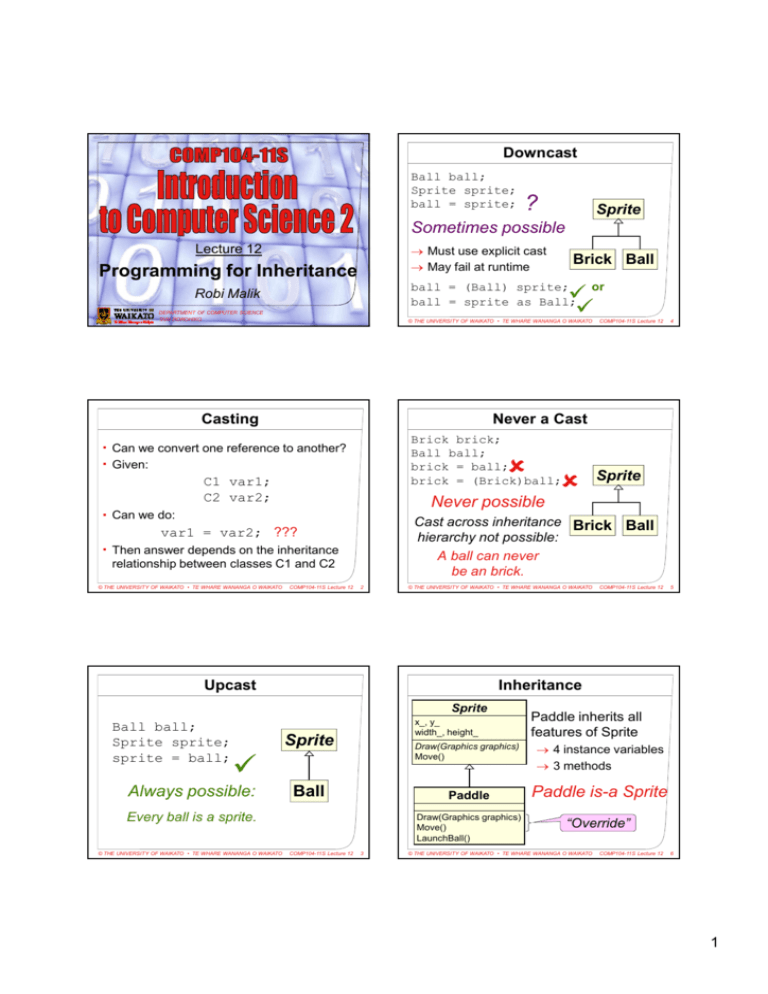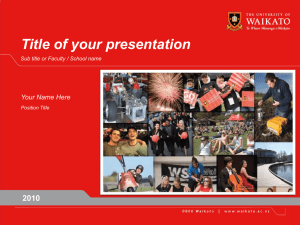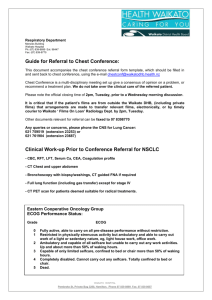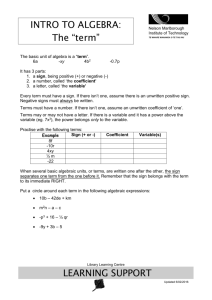base
advertisement

Downcast
Ball ball;
Sprite sprite;
ball = sprite;
?
Sprite
Sometimes possible
Lecture 12
→ Must use explicit cast
→ May fail at runtime
Programming for Inheritance
or
ball = (Ball) sprite;
ball = sprite as Ball;
Robi Malik
DEPARTMENT OF COMPUTER SCIENCE
TARI ROROHIKO
© THE UNIVERSITY OF WAIKATO • TE WHARE WANANGA O WAIKATO
Casting
Brick brick;
Ball ball;
brick = ball;
brick = (Brick)ball;
C1 var1;
C2 var2;
Never possible
Can we do:
Then answer depends on the inheritance
relationship between classes C1 and C2
COMP104-11S Lecture 12
2
x_, y_
width_, height_
Sprite
Draw(Graphics graphics)
Move()
Ball
Paddle
Every ball is a sprite.
© THE UNIVERSITY OF WAIKATO • TE WHARE WANANGA O WAIKATO
Sprite
COMP104-11S Lecture 12
5
Inheritance
Sprite
Always possible:
© THE UNIVERSITY OF WAIKATO • TE WHARE WANANGA O WAIKATO
Upcast
4
Cast across inheritance Brick Ball
hierarchy not possible:
A ball can never
be an brick.
var1 = var2; ???
Ball ball;
Sprite sprite;
sprite = ball;
COMP104-11S Lecture 12
Never a Cast
Can we convert one reference to another?
Given:
© THE UNIVERSITY OF WAIKATO • TE WHARE WANANGA O WAIKATO
Brick Ball
Draw(Graphics graphics)
Move()
LaunchBall()
COMP104-11S Lecture 12
3
Paddle inherits all
features of Sprite
→ 4 instance variables
→ 3 methods
Paddle is-a Sprite
“Override”
© THE UNIVERSITY OF WAIKATO • TE WHARE WANANGA O WAIKATO
COMP104-11S Lecture 12
6
1
Composition/Association
Paddle
Also Works with Interfaces
interface IDrawable {
public void Draw();
}
Game
1
Draw(Graphics graphics)
paddle_
Move()
LaunchBall()
score_
Tick()
class Star : IDrawable { … }
class Ship : IDrawable { … }
Game owns/uses an instance of Paddle
Star
→ Can call methods: paddle_.Move();
→ Update association:
paddle_ = new Paddle();
COMP104-11S Lecture 12
7
Polymorphism
Sprite
x_, y_
width_, height_
Draw(Graphics graphics)
Move()
Paddle
Draw(Graphics graphics)
Move()
LaunchBall()
COMP104-11S Lecture 12 10
A class can inherit from only one class
But it can implement any number of
interfaces
score_
Tick()
public class Ball :
Sprite, IDrawable,
ICloneable
{
…
Subclass of Sprite, also
}
implements IDrawable and
ICloneable
Polymorphism
=
Composition
+
Inheritance
© THE UNIVERSITY OF WAIKATO • TE WHARE WANANGA O WAIKATO
© THE UNIVERSITY OF WAIKATO • TE WHARE WANANGA O WAIKATO
Single or Multiple Inheritance
Game
*
sprites_
Ship
IDrawable[] items;
foreach (IDrawable item in items) {
item.Draw();
}
Game has-a Paddle
© THE UNIVERSITY OF WAIKATO • TE WHARE WANANGA O WAIKATO
IDrawable
COMP104-11S Lecture 12
8
© THE UNIVERSITY OF WAIKATO • TE WHARE WANANGA O WAIKATO
COMP104-11S Lecture 12 11
Polymorphism in Action
Overriding
Game has a member of class Sprite
Methods declared as
abstract or virtual
can be overridden in a subclass.
→ or Paddle
→ or Ball
→ or /
Must use overridekeyword.
Game calls: sprite_.Move()
Must use same method name, parameters,
and return type.
This must execute the correct code:
→ Paddle.Move()
→ or Ball.Move()
→ or /
© THE UNIVERSITY OF WAIKATO • TE WHARE WANANGA O WAIKATO
Must use less restrictive access modifier.
Can use base to call superclass method.
COMP104-11S Lecture 12
9
© THE UNIVERSITY OF WAIKATO • TE WHARE WANANGA O WAIKATO
COMP104-11S Lecture 12 12
2
Copy Constructors
Deep Copy
class Product {
public Product(Product p)
Product
{
code_ = p.code_;
code_
description_ =
description_
p.description_;
price_
price_ = p.price_;
}
}
class Book : Product {
public Book(Book b) : base(b)
Book
{
author_ = b.author_;
author_
}
}
© THE UNIVERSITY OF WAIKATO • TE WHARE WANANGA O WAIKATO
COMP104-11S Lecture 12 13
mesh
:Mesh
:Mesh
triangles_
triangles_
:List
:List
contents_
copy
contents_
public Mesh(Mesh mesh) {
triangles_ = new List<Triangle>();
foreach (Triangle t in mesh.triangles_)
triangles_.Add(new Triangle(t));
}
© THE UNIVERSITY OF WAIKATO • TE WHARE WANANGA O WAIKATO
COMP104-11S Lecture 12 16
The ICloneableInterface
Shallow vs. Deep Copy
class Mesh {
Polymorphic Object Duplication
private List<Triangle> triangles_;
public Mesh(Mesh mesh)
{
triangles_ = mesh.triangles_;
}
}
© THE UNIVERSITY OF WAIKATO • TE WHARE WANANGA O WAIKATO
COMP104-11S Lecture 12 14
The Clone() method returns a
duplicate of the object it is called for.
May be shallow or deep copy
depending on application.
© THE UNIVERSITY OF WAIKATO • TE WHARE WANANGA O WAIKATO
COMP104-11S Lecture 12 17
Implementing ICloneable
Shallow Copy
mesh
public interface ICloneable
{
public object Clone();
}
:Mesh
:Mesh
triangles_
triangles_
public class Flight : ICloneable {
copy
:List
Using copy constructor
public object Clone() {
return new Flight(this);
}
contents_
Using memberwise clone:
public Mesh(Mesh mesh)
{
triangles_ = mesh.triangles_;
}
© THE UNIVERSITY OF WAIKATO • TE WHARE WANANGA O WAIKATO
COMP104-11S Lecture 12 15
public object Clone() {
Flight flight =
(Flight) MemberwiseClone();
flight.bookings_ = new List<Booking>();
return flight;
}
© THE UNIVERSITY OF WAIKATO • TE WHARE WANANGA O WAIKATO
COMP104-11S Lecture 12 18
3
The this Reference
Every method is applied to a particular
object of its class.
A reference to that object is stored in
the special variable this.
We can use this to pass the current
object as an argument to another
method.
return new Flight(this);
© THE UNIVERSITY OF WAIKATO • TE WHARE WANANGA O WAIKATO
COMP104-11S Lecture 12 19
Universal Base Class object
All classes are subclasses of
object
and inherit the following methods:
public
public
public
public
public
public
object MemberwiseClone();
string ToString();
bool Equals(object obj);
Type GetType();
int GetHashCode();
void Finalize();
© THE UNIVERSITY OF WAIKATO • TE WHARE WANANGA O WAIKATO
COMP104-11S Lecture 12 22
The MemberwiseClone()Method
Using a Dictionary
public object MemberwiseClone();
A dictionary (or associative map)
is used to map keys to values.
Allocates memory for a new object
Initialises the new object with the data
from the object it is called on
→ by byte-wise copying
Works like shallow copy
© THE UNIVERSITY OF WAIKATO • TE WHARE WANANGA O WAIKATO
COMP104-11S Lecture 12 20
Cloning vs. Copy Constructor
Copy Constructors
are class-specific.
always return the proper type.
→ Usually the preferred solution
Cloning
works for all objects implementing
ICloneable.
returns an unspecified object, casting may
be needed.
→ Only for polymorphic use
© THE UNIVERSITY OF WAIKATO • TE WHARE WANANGA O WAIKATO
COMP104-11S Lecture 12 21
Dictionary<string,string> dict =
new Dictionary<string,string>();
dict.Add("cat", "domestic");
dict.Add("dog", "domestic");
dict.Add("kiwi", "New Zealand");
dict.Add("llama", "South America");
…
string home = dict["kiwi"];
© THE UNIVERSITY OF WAIKATO • TE WHARE WANANGA O WAIKATO
COMP104-11S Lecture 12 23
Hash Tables
Dictionaries are implemented as hash
tables.
Keys and values are stored in an array of
fixed size.
When adding or looking up a key, a unique
hash code is computed from the key's data
and used as index in the table.
→ Obtained using GetHashCode().
→ Typically random, but equal keys give equal
hash codes.
© THE UNIVERSITY OF WAIKATO • TE WHARE WANANGA O WAIKATO
COMP104-11S Lecture 12 24
4
Hash Table Object Diagram
"cat".GetHashCode() == 13
"dog".GetHashCode() == 5
"kiwi".GetHashCode() == 7
"llama".GetHashCode() == 5
:Dictionary
contents_
0
1
2
3
4
5
Equals()and GetHashCode()
6
7
8
9
10
11
:KeyValuePair
12
13
14
15
:KeyValuePair
"dog"
value_ "domestic"
"cat"
value_ "domestic"
key_
key_
:KeyValuePair
"kiwi"
value_ "New Zealand"
key_
All classes inherit the methods Equals()
and GetHashCode() from object.
The default implementation is based on
object identity.
→ Equality of memory addresses.
This is usually what you want.
If you want to use objects as dictionary
keys, you may have to override Equals()
and GetHashCode().
→ This is not easy!
© THE UNIVERSITY OF WAIKATO • TE WHARE WANANGA O WAIKATO
COMP104-11S Lecture 12 25
© THE UNIVERSITY OF WAIKATO • TE WHARE WANANGA O WAIKATO
COMP104-11S Lecture 12 28
Hash Collisions
About Hash Tables
Occasionally two keys have the same
hash code and are mapped to the
same table cell.
Hash tables provide constant-time insert
and lookup operations based on keys
O(1)
→ This is called a collision.
Each table cell may contain more than
one entry.
→ The so-called overflow list.
To find the right key, the method
Equals() is used.
© THE UNIVERSITY OF WAIKATO • TE WHARE WANANGA O WAIKATO
:Dictionary
2
3
4
5
6
7
8
9
10
11
12
13
14
15
:KeyValuePair
:KeyValuePair
key_
© THE UNIVERSITY OF WAIKATO • TE WHARE WANANGA O WAIKATO
COMP104-11S Lecture 12 29
Reading
C# for Students
contents_
1
the hash function gives an even
distribution;
the hash table is big enough.
COMP104-11S Lecture 12 26
Hash Collision Object Diagram
0
assuming that:
"kiwi"
value_ "New Zealand"
next_
null
Chapter 24:
Polymorphism
pp. 408–418
key_
"dog"
value_ "domestic"
next_
:KeyValuePair
key_
“llama"
value_
“Peru"
null
next_
Murach’s C# 2008
:KeyValuePair
"cat"
value_ "domestic"
next_
null
key_
© THE UNIVERSITY OF WAIKATO • TE WHARE WANANGA O WAIKATO
COMP104-11S Lecture 12 27
Chapter 14:
How to work with inheritance
pp. 411–448
© THE UNIVERSITY OF WAIKATO • TE WHARE WANANGA O WAIKATO
COMP104-11S Lecture 3
30
5








